| @ |
gHomeh can mean many things, not simply a ghouseh as the smallest unit within a larger community. It can also refer to a gnationh as a political community, a ghometownh as a place to which one may return, a gdeparture pointh where something is created or generated, gush as the result of a conceptual grouping, or even as a gsafe refuge of the soulh. It may be said that the concept of ghomeh begins when people create a society or community, and subsequently come to understand the borders of that society. Therefore the loss of a ghomeh may have various meanings above and beyond the simple loss of onefs place of residence. The upcoming Artist in Residence Program and its accompanying exhibition will be composed with this theme of ghomeh as its key.
yArtistsz
@Cornelia KONRADS (Munder, Germany)
@PARK HyesooiSeoul, Koreaj
@OH Haji (Osaka, Japan)
@ONISHI YasuakiiOsaka, Japanj@
ySchedulez
@
Period of stay : Sept. 24 | Dec. 19
Exhibition : 14 Nov. | Dec.13 10:00-19:00
yEventz
Opening
Nov. 14 (Sat.) 13:30 -
Opening Artistsf Talk
Nov. 14 (Sat.) 14:00 - 15:00
Slide Lecture
Nov. 23 (Mon) PARK Hyesoo Lecture & Art project gAsk your scenth 14:00\16:00 (Korean & Japanese)
Nov. 28 (Sat.) OH Haji gConnecting memories\through my worksh 14:00\15:00 (Japanese)
Nov. 29 (Sun.) Cornelia KONRADS gbetween rising and falling- site specific sculptures in the landscape -h
14:00\15:30 (English & Japanese)
Dec. 12 (Sat.) ONISHI Yasuaki gAbout My work | Making the clueh 14:00\15:00 (Japanese)
Family Wrokshop gMaking family clock using photo imagesh@application deadline is Nov. 27 (Fri.)
Dec. 5 (Sat.) 14:00\16:00 for 20 participants Instructor: PARK Hyesoo Fee: 800JPY
Gallery Talk by Curator (Japanese)
Dec. 13 (Sun.) 14:00\15:00
Art Documentary film gCornelia Konrads THE GATEh (40min.) (French & English & Japanese)
film by Antoine de Roux, @
Dec. 13 (Sun.) (1) 11:00--@ (2) 15:00-- (3) 17:00--@@@@
|
@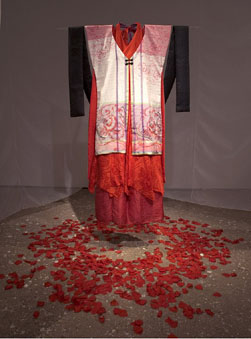
@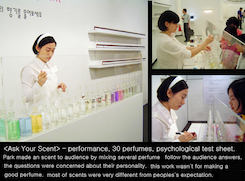
ªimage for PARK Hyesoo gAsk your scenth
@ 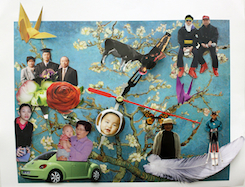
ªFamily Wrokshop gMaking family clock using photo imagesh@
|
@ |
| |
yartistsz
¡Cornelia KONRADS (Munder, Germany)
Born in Wuppertal, Germany and currently lives and works in MuNnder, Germany. Studied about Philosophy, Cultural Science.
gI like to cause a moment of irritation by adding an element to the scenery, which refuses to fit into the expected order. Showing up gby the wayh, it is not sure, if it was always there; if it will change or disappear in the next second. For this moment of irritation I like to challenge, what is supposed to be greliableh about reality: the laws of gravity, the solidity of walls or the ground under our feetc The shown situation can be seen as a filmstill, pointing backwards and forwards both temporally and spatially\an interim state, reflecting my idea of transience, passage and transformation.h (from the Artistfs statement for the AIR program ghomeh)
|
|
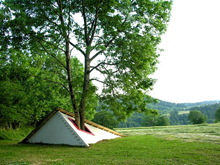
Still life with Tree, 2008 |
|
|
|
¡PARK Hyesoo (Seoul, Korea)@
Born in Seoul, Korea. Completed from the EWHA Women's University (Sculpture).
gFor me, Art chronicles all the process involved in embodying my idea. My work is based on concepts open to directions, with countless possibilities. It always begins from questions about trivial life. When I use a poem, music, or film, my art and my sensibilities become enriched, and specified through studying materials, finally achieved when questioned. Divers Ideas at time coexist and develop in another direction, as if life changes according to the people we meet. Although we make countless plans, nobody knows what will happen tomorrow. My life is the exploration of what I am wondering, and my drawing is the chronicle of the processes involved. If these process record what I image, worry about, and realize, Ifm not a creator, but a chronicler, a collector.h (from the Artistfs statement for the AIR program ghomeh) |
|
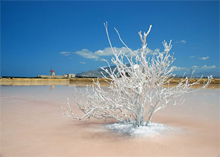
Beautiful Sorrow, 2007. |
| |
¡ONISHI Yasuaki (Osaka, Japan)
Born in Osaka. Completed from Kyoto City University. Currently lives and works in Osaka, Japan.
gI am interested in the visible and the invisible thing. Through my art work, I get information from the space and leave clues on the space. Form, color and movement is changed to the simple element, like points, lines and lights. It tells us the limited information. I would like to show the way of perception of this world through my work. Though each work doesnft mean some specific matter or story, it will stimulate each imagination and thought. I think we can discover new value from the trivial matters.h (from the Artistfs statement for the AIR program ghomeh) |
|
|
|
|
restriction sight AAC, 2007. |
¡OH Haji iOsaka, Japanj
Born in Osaka. Completed from Kyoto City University from crafts division, dyeing and weaving department. Currently lives and works in Kyoto, Japan.
gI believe the meaning of Hanbok to Korean-Japanese is not about patriotism for consciousness of ethnicity. We need to establish our own identities in Japan. My art/ costume is not eFashionf. Ethnic costumes express a lifestyle and thoughts about ethnicity. It begins from yarn, and with the accumulation of time, at and wisdom of humans, it is completed. It is not about fashion. It is a philosophy that is immeasurable. My art makes it possible to continue to show peoplefs time from their roots.h (the Artist statement from the flier of the exhibition gOrientity: oriental+ identityh, Kyoto Art Center, 2004.)
|
|
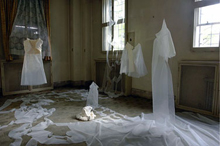 Being of emptiness, 2008. Being of emptiness, 2008. |
|
|
|
|
|